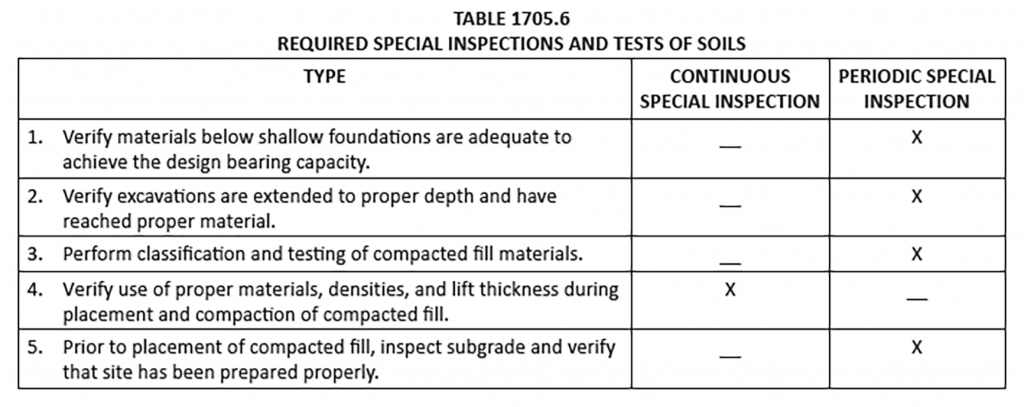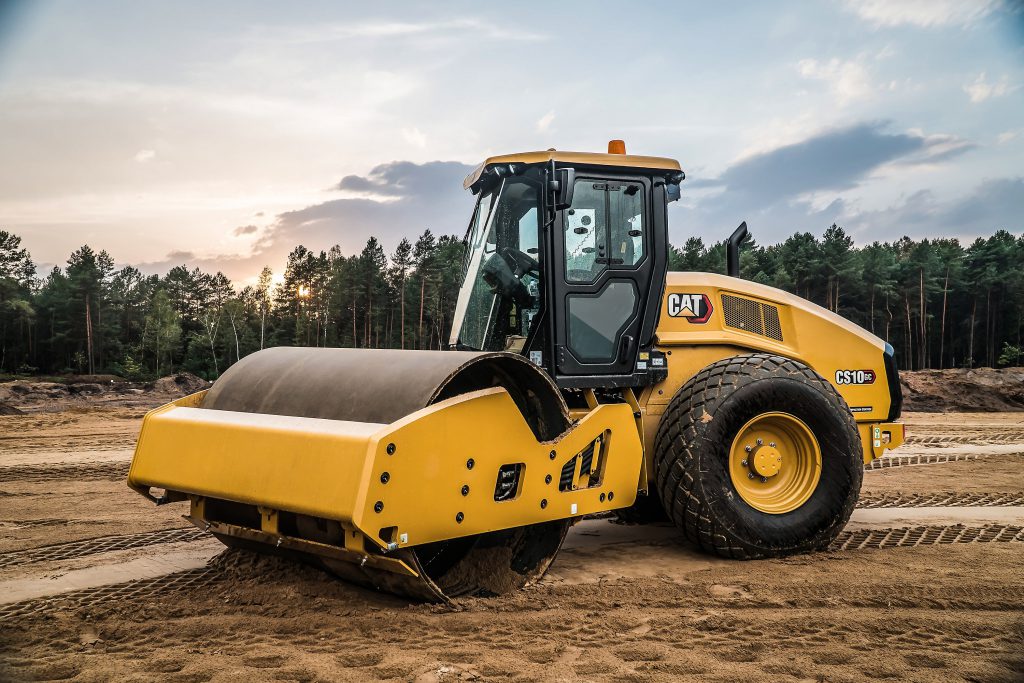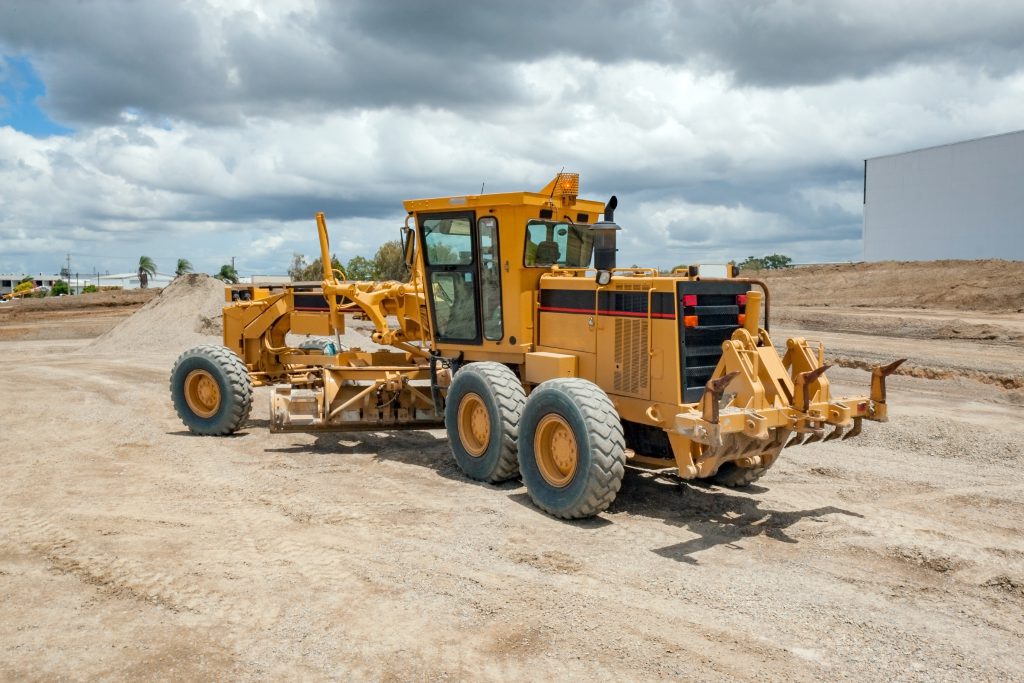Lesser-known soils special inspections: all the dirt according to chapter 18 of the ibc code
The soil special inspections required by IBC Section 1705.6 and Table 1705.6 should be familiar to anyone who provides, specifies, or reviews soil special inspections. The code-required special inspections listed in Table 1705.6 are vital elements to verify the designed bearing capacity of in-place soils, thereby limiting potential settlement. Chapter 18 of the IBC code lists additional special inspections and tests that are just as important as those listed in Chapter 17. The special inspections and tests listed in Chapter 18 are probably lesser-known. That said, they are still CODE and cover a lot of mandatory compliance criteria.

Table 1705.6 conveys the requirements for determining soil-bearing capacity, testing, and inspection of soils for controlled fill. Section 1705.6 instructs the soil special inspector to verify that earthwork procedures and materials comply with the approved geotechnical report. This single requirement of code compliance criteria is HUGE. Project compliance with the geotechnical report is code-driven, and much of that compliance criteria must be observed and verified by the special inspector during construction phases. The average geotechnical report is probably 30+ pages in length and often contains an additional 20 to 30 pages of appendices, laboratory test data, reference standards, and the like.

Now that we have briefly recapped the main takeaways of IBC Section 1705.6, let’s move on to another lesser-known source of soils compliance criteria: Chapter 18, “Soils and Foundations.” This chapter sets forth the minimum requirements for designing and constructing foundation systems for buildings and other structures. It consists of ten primary code sections:
- Section 1801 gives the general scope and purpose of Chapter 18 provisions
- Section 1802 establishes the design basis for allowable loads and stresses for foundations
- Section 1803 provides requirements for foundation and geotechnical investigations to be conducted at the site prior to design and construction
- Section 1804 includes excavation, grading, and backfill provisions
- Section 1805 provides specifications for damp-proofing and waterproofing floor slabs and below-grade walls
- Section 1806 establishes allowable lead-bearing values for soils where site soil tests do not verify that higher soil values are appropriate
- Section 1807 provides requirements for foundation walls, retaining walls, and embedded posts
- Section 1808 gives general requirements for foundations
- Section 1809 provides the specifications for shallow foundations
- Section 1810 includes the provisions for deep foundations
Several Chapter 18 sections contain critical code acceptance criteria involving various construction disciplines. Section 1803 addresses several key geotechnical engineering requirements and mandates geotechnical investigations on projects (Section 1803.2). However, a building official has the option to waive the mandate as long as there is access to specific subsurface data listed in other 1803 sections. Section 1803 stipulates the geotechnical report’s minimum required information regarding shallow and deep foundations. This section also addresses the groundwater table, rock strata, expansive soils, etc. The soil special inspector should be familiar with the geotechnical report to verify compliance with the geotechnical recommendations during project earthwork phases.
Section 1803 addresses controlled low-strength material (CLSM, also known as flowable fill) where shallow foundations will bear on the CLSM material. Significant CLSM code compliance criteria is included in Section 1803, such as specifications for the preparation of the site before the placement of CLSM, CLSM specifications, and laboratory field tests to monitor CLSM compressive strength. Whenever applicable, all the code compliance criteria should be field verified by the special inspector. Guidance for the CLSM mix proportions can be found in ACI 229R, “Report on Controlled Low-Strength Materials (CLSM).”
The contents of Chapter 18, Section 1804 are essential during earthwork construction phases, as this section addresses the stability of adjacent foundations when excavations occur. A significant portion of this section’s commentary addresses slope stability during the excavation process, underpinning, site grading, and backfill placement.
Section 1806 contains Table 1806.2, “Presumptive Load-Bearing Values,” which is used with the allowable stress design load combinations specified in Section 1605.3. The values in Table 1806.2 are lower-bound allowable pressures used where the bearing value is not determined by soil borings as specified in Section 1803. If a geotechnical professional encounters bearing values in the field that are less than those listed in Table 1806.2, they can use their local experience and knowledge to establish the appropriate minimum load-bearing values on the site with the approval of the building official.

Section 1807 includes criteria for locating buildings adjacent to slopes. The recommended setback protects the structure from shallow slope failures, erosion, and slope drainage.
IBC Chapter 18, “Soils & Foundations,” requires numerous soil inspections and tests not stipulated in IBC Chapter 17, “Special Inspections and Tests.” It is essential to recognize that the tests and inspections cited in Chapter 18 are code-required, just as are those outlined in Chapter 17. The geotechnical report often stipulates the inspections and tests required by Chapter 18. When no subsurface investigation has been done on a project, and a geotechnical report does not exist, the special inspector often does not provide the inspections and tests required by Chapter 18.
Note: The lack of a geotechnical report does not negate the inspections and tests required by Chapter 18. A project should follow code compliance criteria listed in Chapter 18 regardless of whether or not a geotechnical report exists. IBC Chapter 18, Section 1803 requires a geotechnical investigation unless the building official waives it. However, waiving the geotechnical report does not waive the code compliance criteria in Chapter 18.
So what should the special inspector do when initiating special inspection field services on a compacted fill building construction project where a geotechnical report does not exist? At a minimum, the special inspection agency should include the services of a geotechnical engineer on the compacted fill portion of the project. All applicable Chapter 17 and 18 code criteria should be followed.
But Wait — We Have a Lot More to Say! For a complete picture of the Code and how it relates to Special Inspections, F&R would love to provide a virtual (for the time being) AIA-accredited Lunch & Learn presentation to the professionals at your firm.
Trouble Deciphering the Code? Call the Experts at F&R!
Alan S. Tuck
Director of Code Compliance & Training
T 540.344.7939
M 540.798.4440
atuck@fandr.com
Table 1705.6 conveys the requirements for determining soil-bearing capacity and testing and inspection of soils for controlled fill. Section 1705.6 instructs the soil special inspector to verify that earthwork procedures and materials comply with the approved geotechnical report. This single requirement of code compliance criteria is HUGE. Project compliance with the geotechnical report is code-driven, and much of that compliance criteria must be observed and verified by the special inspector during construction phases. The average geotechnical report is probably 30+ pages in length and often contains an additional 20 to 30 pages of appendices, laboratory test data, reference standards, etc.
Table 1705.6 conveys the requirements for determining soil-bearing capacity and testing and inspection of soils for controlled fill. Section 1705.6 instructs the soil special inspector to verify that earthwork procedures and materials comply with the approved geotechnical report. This single requirement of code compliance criteria is HUGE. Project compliance with the geotechnical report is code-driven, and much of that compliance criteria must be observed and verified by the special inspector during construction phases. The average geotechnical report is probably 30+ pages in length and often contains an additional 20 to 30 pages of appendices, laboratory test data, reference standards, etc.

